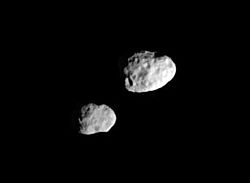Co-orbital moons are natural satellites that orbit at the same (or very similar) distance from their parent planet as each other. Only the Saturn system is known to have co-orbital moons, and it has three sets.
Two of these are sets of Trojan moons, which are unique only in that they orbit a planet rather than the Sun (there are several thousand known Trojan asteroids). In a Trojan configuration, one or more moons orbits at the stable Lagrange point, 60° behind or ahead of a much more massive moon. The massive moon is not perceptibly affected by the relatively tiny Trojans (see restricted three-body problem). Saturn's moon Tethys has two Trojan moons (Telesto and Calypso), and Dione also has two Trojan moons (Helene and Polydeuces).
Much more unusual are the Saturnian moons Janus and Epimetheus, which are truly co-orbital and are not Trojans. Janus is more massive than Epimetheus, but only by a factor of four, so each moon exerts a significant influence on the other. In this case, the two moons both oscillate about their mass-weighted mean orbit.
Orbital relationship between Epimetheus and Janus

Janus and Epimetheus are co-orbital: Janus' mean orbital radius from Saturn is currently only 50 km less than that of Epimetheus. This is smaller than either moon's diameter. Since closer orbits have higher velocities, the two moons must inevitably approach each other, and it would seem at first glance that a collision would be inevitable. But as the inner moon catches up with the outer moon their mutual gravitational attraction boosts the inner moon's momentum and raises its orbit, causing it to slow down. At the same time, the outer moon equally loses momentum and drops into a lower orbit. The moons thus "trade" orbits and begin to move apart again, since the forward moon is now in the lower, faster orbit. The nearest they ever approach is some 10,000 km. The exchange takes place about once every four years; the last close approach was on 21 January 2006,[1] the next will be in 2010. At that time, Janus' orbital radius will increase by ~20 km, while Epimetheus' decreases by ~80 km; Janus' orbit is less affected because it is 4 times more massive than Epimetheus. As far as it is currently known, this arrangement is unique in the solar system.
The orbital relationship between Janus and Epimetheus can be understood in terms of the circular restricted three-body problem, as a case in which the two moons (the third body being Saturn) are similar in size to each other. Other examples of the three-body problem include the Lagrangian points, Trojan asteroids and Trojan moons, the "horseshoe" orbit of Cruithne with respect to Earth, and potentially dozens of other objects in similar orbits.[2]


0 comments:
Post a Comment